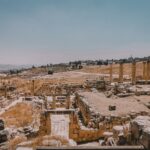Nestled in the ancient city of Ephesus, near the modern town of Selçuk in Turkey, lie the remnants of one of the Seven Wonders of the Ancient World—the Temple of Artemis. Once a magnificent structure dedicated to the goddess of the hunt, wilderness, and fertility, the Temple of Artemis was a symbol of both religious devotion and architectural brilliance. Today, although only a few columns remain, the temple continues to captivate the imagination of visitors from around the world.
A Glorious Monument to the Goddess Artemis
The Temple of Artemis, also known as the Artemision, was built in honor of Artemis, one of the most revered deities in the ancient Greek pantheon. The original temple was constructed in the 6th century BCE under the patronage of the Lydian king Croesus, but it was later destroyed by a flood. The more famous iteration, completed in 550 BCE, was designed by the renowned Greek architect Chersiphron and his son Metagenes.
This monumental temple was unlike anything the ancient world had seen. Measuring 115 meters in length and 55 meters in width, it was adorned with over 120 intricately carved columns, each standing 18 meters tall. The temple’s grand scale, exquisite sculptures, and lavish decorations made it a site of pilgrimage and admiration for centuries.
The Cultural and Religious Significance
The Temple of Artemis was not only an architectural marvel but also a central place of worship and commerce in Ephesus. As one of the largest temples of the ancient world, it drew visitors from far and wide who came to pay homage to Artemis, participate in religious festivals, and engage in trade. The temple also housed many valuable works of art, including sculptures by famous artists such as Pheidias and Polyclitus.
Artemis herself was a goddess of many attributes, revered not only as the protector of the natural world and the guardian of childbirth but also as a symbol of fertility and feminine strength. The temple served as a spiritual center for her worship, reflecting the deep cultural and religious importance of Artemis in the lives of the people of Ephesus and the surrounding regions.
The Fall of the Temple and Its Legacy
The Temple of Artemis endured several destructions throughout its history. The first major blow came in 356 BCE when it was set ablaze by a man named Herostratus, who sought fame at any cost. Despite this, the temple was rebuilt even more splendidly, only to be destroyed again by the Goths in 262 CE during an invasion of Ephesus.
Over time, as Christianity spread through the Roman Empire and Ephesus declined in importance, the temple fell into ruin. By the end of the 4th century CE, it was largely abandoned, and its stones were repurposed for other buildings, including churches. Today, only a few columns and scattered stones remain to mark the site of this once-glorious temple.
Despite its physical disappearance, the legacy of the Temple of Artemis lives on. It remains a powerful symbol of ancient Greek religion, art, and architecture, and continues to inspire awe and wonder in all who learn about its history.
Visiting the Temple of Artemis Today

Best things to do in Japan Nunc lacus elit, faucibus ac laoreet sed, dapibus ac mi. Maecenas eu ante a elit tempus fermentum. Aliquam commodo tincidunt semper. Phasellus accumsan, justo ac mollis pharetra, ex dui pharetra nisl, a scelerisque ipsum nulla ac sem. Integer hendrerit egestas magna, eu pellentesque velit placerat et.
Integer pulvinar dolor eu metus elementum, at commodo erat efficitur. Vivamus sollicitudin, quam a ornare vestibulum, lorem turpis ege stas magna, in lacinia felis arcu sit amet arcu. Cras eu risus urna. Duis lorem sapien, congue eget nisl sit amet, rutrum faucibus elit. Nullam non tortor massa. Proin ligula leo, hendrerit quis tincidunt a, sodales eget ligula.



